Human Operator Dynamics
The overall goal of this research is to determine the joint
mechanical properties of the freely moving human arm, by utilizing a
novel airjet perturbation device and developing time-varying nonlinear
system identification methods. Applications are being pursued for
clinical evaluation of motor deficits and rehabilitation, and for
incorporation of human operator dynamics in teleoperator control
systems.
Airjet Design
The overall goal is to study natural, unconstrained arm movements. To
allow the arm to move freely, it was necessary to design a portable
perturbation device. Our airjet system is a pneumatic thruster
attached to the wrist, which produces high-frequency stochastic
perturbations with a flat response of 75 Hz and a thrust of 4 N.
- A single-axis thruster was designed first and used for
experimentation with the elbow joint (Xu, Hunter, Hollerbach, and
Bennet, 1991).
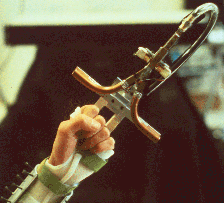
- A computational fluid dynamic analysis has been performed to
optimize the design.
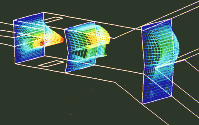
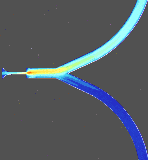
- A two-axis thruster has been recently designed which will allow
the shoulder as well as elbow to be characterized. Tests on an
artificial 1D elbow joint show that the mechanical impedance is well
identified, after corrections for force sensor ringing and for
acceleration loading on the force sensor by the airjet (Xu and Hollerbach, 1995).
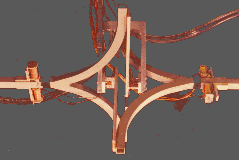
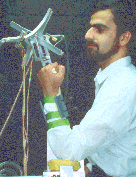
- A passive two-joint planar manipulator, with inertia, damping and
stiffness attributes of the human arm, has been designed to test the
two-axis thruster and multi-joint identification methods.
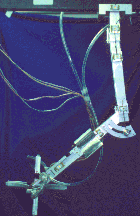
This device places us in a unique position to study
unconstrained arm motions.
Time-Varying Nonlinear System Identification
Considerable effort has been placed on developing two robust
identification methods:
- a single trial method, based on exponentially weighted least
squares (EWLS), and
- a new ensemble method, the highpass mean removal
ensemble data (HMRED) method.
These methods address problems and artifacts potentially due to
ensemble methods.
- The EWLS method avoids such problems by requiring only a single
trial; it can capture linear time-varying dynamics in posture and slow
movement (Xu and Hollerbach, 1996b).
- The HMRED method is suitable for both slow and fast movements; it
avoids the problem of mean removal with previous ensemble methods (Xu
and Hollerbach, 1996a).
The EWLS and HMRED methods have been calibrated against each
other in a slow movement task: they both yield very close results (Xu and Hollerbach, 1993). Such a calibration is
particularly important because the result on the human limb
identification often varies with the method used in the
literature.
We have also done preliminary experiments to check whether small
random force perturbations alter the mechanical properties of the
elbow joint in posture. We compared the pulse responses evoked by a
pulse force with or without superimposed random force perturbations.
We found that random force perturbations have little effect on the
pulse response, and the pulse response is consistent with the
mechanical properties obtained through random perturbations
(Xu and Hollerbach, 1994).
In the future, we will begin experiments on two-joint posture and
motion, including the shoulder as well as the elbow.
 John M. Hollerbach
John M. Hollerbach
 Biorobotics Laboratory
Biorobotics Laboratory











